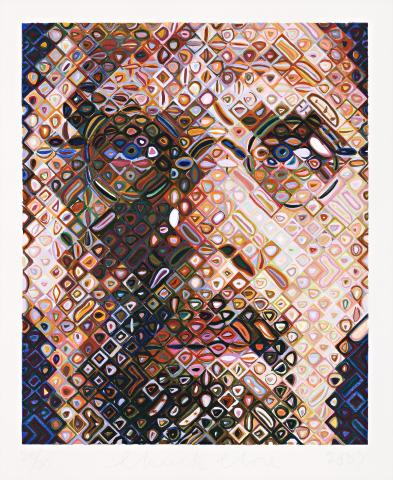SELF PORTRAIT WOODCUT, 2009
CHUCK CLOSE
47 colour woodcut
71.0 x 58.5 cm (image)
90.5 x 72.5 cm (sheet)
published by Pace Editions, Inc., New York
signed, dated and numbered below image: 20/70 Chuck Close 2009
Pace Gallery, New York
Utopia Art, Sydney (label attached verso)
Private collection, Sydney
purchased from the above in 2010
Utopia Art Sydney, at the Melbourne Art Fair, Melbourne, 4 – 7 August 2010
Chuck Close Prints, Utopia Art Sydney, Sydney, 28 August – 2 October, 2010
Another example from this edition is in the collection of the Museum of Modern Art, New York
No other artist could claim the title of postmodern portraitist with more conviction than the American painter Chuck Close. Close’s unwavering commitment to painting and to the genre of portraiture showed great resolve and remained surprisingly analogue against many successive waves of technological change. This being said, Close did address these technological changes and filtering them into his practice in innovative ways. One could be forgiven for thinking that Close’s practice was to do with painting people, in fact, it has more to do with portrait photography and how this intersects with the ancient practice of painted portraiture. Chuck Close’s hyperrealist portraits, exhaustive in their many modes of execution (from mezzotint to tapestry to computer-generated watercolour collages), all feature an extreme reduction of form, a disassembly of the structural, tonal and linear components of a portrait, only to be reassembled on a grand scale.
Close is a conceptual artist whose subject of inquiry is his own process. His artworks are not photographs, they are, rather, painted versions of photographic portraits, executed in manual techniques. Self Portrait, 2009 is a woodblock print in the Japanese style of ukiyo-e, the oldest form of relief painting, formed by cumulative excision of successive woodblocks, inking and printing the elevated sections on the same leaf of paper. This woodcut exemplifies Close’s extraordinary technique, created in 47 colours, using 26 woodblocks following the skewed grid format that Close first used in painted portraits in the early 1990s. Here, even the most minute of tonal differences in the artist’s skin are exaggerated into their own small colour field, in a similar way to how pixels make up a computer display. The differences here are almost atomic and use highly saturated colours beyond the subtractive CYMK model (cyan, yellow, magenta, key/black) used in digital projection; Close has devised a sort of contemporary Pointillism.
Guided by rigourous rationalism, Close’s portraits occupy the space between representation and abstraction. Close has dismantled visual perception into its essential components, constructing his images of these cellular building blocks of colour, line and shape. As a result it leaves its process in apparent view, revealing unashamedly the tricks of the eye to the viewer. Through a precise calculation of ratio, the viewer is able to shift their focus, seeing either a recognisable portrait or a kaleidoscopic field of riotous colour at any one time. When not looking at the sitter, we observe the means with which his image is reproduced. By filling each lozenge with concentric fields of colour, some of which burst over to adjacent cells, the overall effect of the work is hypnotic.
By presenting a close-up view of the artist’s face, in a larger-than-life scale and with a relatively shallow depth of field, Close heightens the unflinching interlocution of the viewer that his gaze provides. As a self-portrait, Close’s work is exceedingly self-reflexive. Not only does it take for subject the artist’s own face, as he has done many times throughout his long and productive career, but it also translates his prosopagnosia (inability to recognise faces) from a social hindrance to an artistic gift, allowing him to enjoy the minutiae that make up the first interface we present to the outside world.
LUCIE REEVES-SMITH
